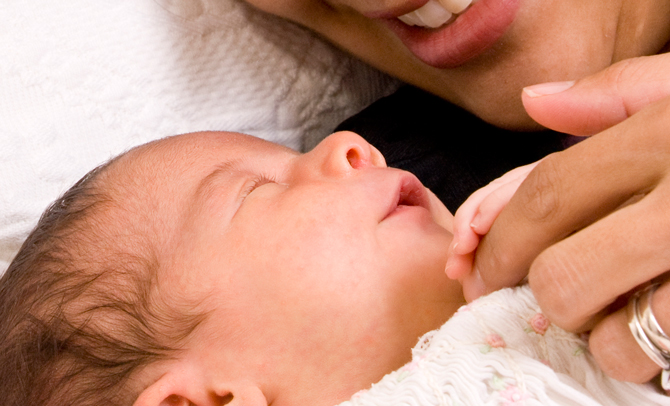Like every mother, Kyra Oliver of Richmond loves to recall the early days of parenthood. She vividly remembers the days spent bonding with her infant son.
“Hayes was a very contented baby,” she says. “He loved to laugh, and he cooed and smiled a lot. He loved to be outside in the breeze. And he really loved Big Bird.”
But in 2002, when Hayes was not yet even 5 months old, Kyra experienced every new mother’s worst fear. Hayes, despite perfect health, stopped breathing and lost his short life to Sudden Infant Death Syndrome (SIDS)
In the days that followed, Kyra resolved to turn her grief into something positive, something that would save other families from meeting the same fate. She began to look for charities that supported SIDS research and prevention.
“I couldn’t find any,” she says. “Everything I could find had to do with bereavement support. And of course that is important, but I really was more focused on prevention.”
Thus began the Hayes Foundation, which works under Kyra’s leadership to educate parents and communities on this heartbreaking condition
The foundation’s most recognizable influence is in the “This Side Up” onesies it distributes through hospitals and birth centers all over the nation. The onesie Design reminds parents that, according to years of SIDS research, a baby is safest sleeping face-up.
“I love to hear people say, ‘They cleaned the baby and brought him back to us in your onesie,’” says Kyra. “That means they’ve already been touched by Hayes, before they even get home with their child.”
Lowering the Risk
As the “This Side Up” campaign suggests, back-sleeping has been the most oft-repeated recommendation in the prevention of SIDS. But the American Academy of Pediatrics (AAP) has several suggestions to help lower the risk:
Choose the right spot for sleep. A crib or bassinet with a firm mattress is best. Never leave your baby to sleep on a soft surface like a stuffed chair or couch.
Share your room, but not your bed. Having your baby nearby is great for monitoring and easy feeding, but co-sleeping is associated with a higher risk of SIDS. A bassinet keeps the baby within reach and earshot without the risk of suffocating in a “grown-up” bed.
Clear the clutter. Remove blankets, stuffed animals, pillows and other items from your baby’s sleeping area. Use sleep-sacks to ensure warmth without the danger of suffocation.
Watch the temperature. Don’t let a sleeping baby get too warm. Resist the urge to crank up the heat in cooler months, and be careful not to overdress your baby.
Breast is best. Breastfeeding through at least 6 months of age has been shown in some studies to reduce the risk of SIDS by as much as half. In one study, 78 percent of babies who had died from SIDS were not breastfed in the month before their death.
“Back” to sleep. Offer lots of tummy time during play, but when it’s time to sleep, put your baby on his back. The careful promotion of that advice alone has reduced the SIDS rate by more than 40 percent since the early nineties.
Share your wishes with caretakers. A disproportionate number of SIDS deaths occur in the care of a family member, babysitter or day care provider. Make sure that anyone who cares for your baby knows how you want your child to sleep – and why.
Recent research has also indicated that the risk can be lowered by using pacifiers (once breastfeeding is well established) and even by keeping a fan on in the room.
“New information is being discovered all the time,” says Kyra. “And that’s part of our goal – not just to educate parents about what we already know about SIDS,but also to learn more about risk factors that can be avoided in the future.”
“We Did Everything Right”
Sarah Webster had just returned to work after a happy maternity leave in 2005 when her 11-week-old daughter, Alexandra, stopped breathing during a nap at the sitter’s house. By the time Sarah made it to the hospital, Alexandra had been pronounced dead from SIDS.
“When our oldest son was born [in 2001], there wasn’t a whole lot of talk about SIDS,” she says. “It was almost a taboo subject. But by the time Alexandra was born, it was in the news all the time.”
Because of that, Sarah says, she knew about the risk factors associated with SIDS. She was careful to follow the guidelines given.
“We were doing everything right,” Sarah says. “Alexandra breastfed right away with no problems. We always put her down on her back, and we know the sitter did the same.”
Sarah says the experience has motivated her to share good advice with new mothers when she can. “I don’t want to scare anyone,” she says, “but education and awareness are so important. If we did all the right things and our daughter still died, I can’t imagine why anyone would take the risk of ignoring any of those guidelines.”
Kyra Oliver, while tirelessly advocating for education and prevention, has a more flexible attitude about the risks associated with SIDS.
“Ultimately, it comes down to what’s best for the family,” she says. “If you have a child who just will not sleep on his back, then you may have to adjust your plans. You can’t go day after day without sleep, so you just do the best you can.
“But if parents are going to take that risk, I want it to be because they weighed all the options and thought it through. I don’t want it to be because they just didn’t know any better.”




